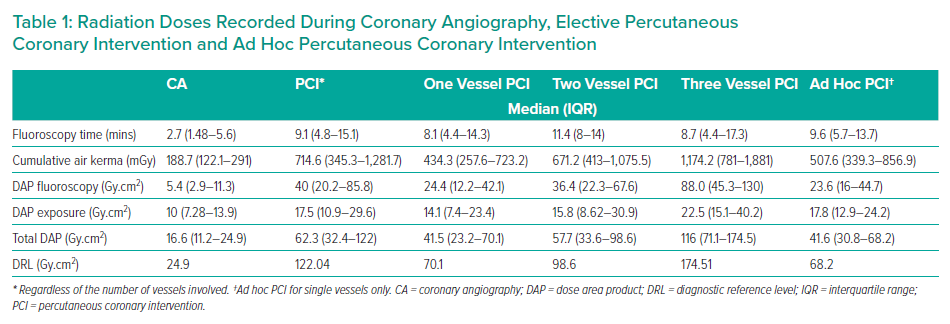Background: With the continuing rise in the number of patients undergoing coronary angiography (CA) and percutaneous coronary interventions (PCI), the significance of radiation safety should always be underscored.
Aim: To establish the first local diagnostic reference levels (DRLs) for CA, elective PCI and ad hoc PCI at the Philippine Heart Center.
Methods: A retrospective review of the medical records of all consecutive patients who underwent CA and PCI from May 1 to December 31, 2019 was done. The DRLs were set from the third quartile (75th percentile) of the median total dose area product (DAP) for each procedure.
Results: There were 2,790 patients in the CA group with a median fluoroscopy time (FT) of 2.7 minutes (interquartile range [IQR] 1.48–5.6), total DAP of 16.6 Gy.cm2 (IQR 11.2–24.9) and DRL of 24.9 Gy.cm2. There were 697 patients in the elective PCI group with a median FT of 9.1 minutes (IQR 4.8–15.1), total DAP of 62.3 Gy.cm2 (IQR 32.4–122) and DRL of 122.04 Gy.cm2. There were 587 patients who underwent single-vessel ad hoc PCI with a median FT of 9.6 minutes (IQR 5.7–13.7), total DAP of 41.6 Gy.cm2 (IQR 30.8–68.2) and DRL of 68.2 Gy.cm2. Higher radiation doses based on the total DAP were seen when the femoral access was used compared to the radial access for CA (18.5 versus 16.2, p<0.001), elective PCI (88.3 versus 52.7, p<0.001) and ad hoc PCI (45.4 to 38.8, p<0.001).
Conclusion: Higher radiation doses were consistently observed when the transfemoral approach was used which suggests that use of the radial access can potentially lower radiation exposure. The local DRLs established may be used as a point of reference for other cardiac catheterisation laboratories in our country.










